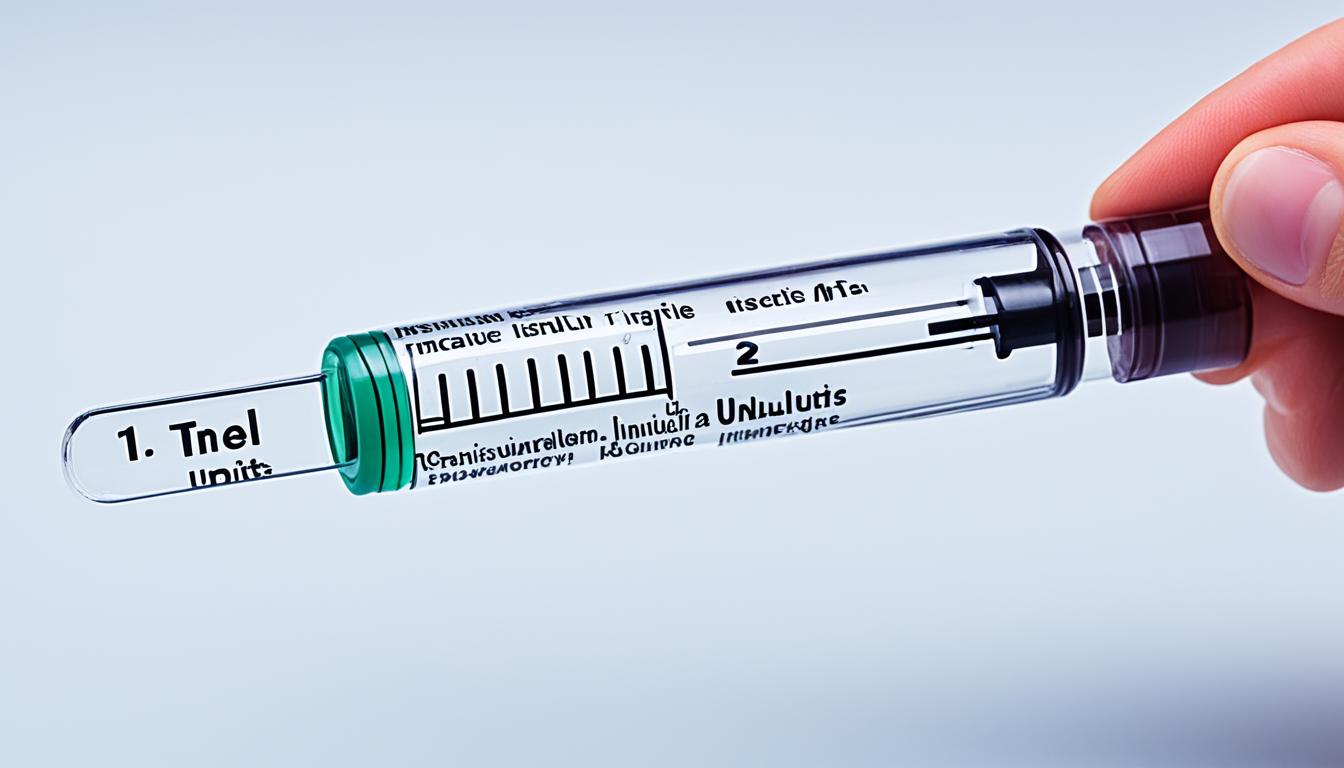When it comes to managing diabetes, having a clear understanding of insulin syringe measurements is essential. Proper dosage calculation and administration play a crucial role in maintaining blood sugar levels and overall health. But how do milliliters (ml) relate to units in an insulin syringe?
In this article, we will explore the relationship between ml and units in an insulin syringe and provide valuable insights into accurate dosage conversion. Whether you’re new to insulin administration or looking to enhance your knowledge, this guide will equip you with the information you need.
Before we dive into the details, let’s clarify the basics. An insulin syringe typically measures dosage in milliliters (ml) and units. Milliliters represent the volume of liquid in the syringe, while units signify the concentration or potency of insulin.
1 Ml is Equal to How Many Units in Insulin Syringe
Determining the conversion between ml and units is critical for accurate dosing. The conversion ratio may vary depending on the concentration of your insulin prescription. It’s important to consult with your healthcare provider or pharmacist for precise guidance specific to your insulin type.
Now that we’ve established the importance of understanding insulin syringe measurements, let’s delve deeper into how to convert ml to units and ensure precise insulin administration. Join us in the next section as we explore the conversion ratio and dosage calculations.
Welcome to the second section of our comprehensive guide on insulin syringe measurements. In this section, we will address the commonly asked question of how many units are equivalent to 1 ml in an insulin syringe. Understanding this conversion is crucial for accurate insulin administration and dosage calculations.
When it comes to ml to units insulin conversion, it’s important to note that the insulin syringe ml to units ratio is not a fixed value. The conversion ratio may vary depending on the concentration of insulin prescribed by your healthcare provider. Typically, insulin concentrations range from 100 units/ml to 500 units/ml.
However, as a general guideline, 1 ml is equal to 100 units in a standard insulin syringe with a concentration of 100 units/ml. This means that if your prescribed insulin dosage is 100 units, you would draw up 1 ml of insulin into the syringe.
It’s worth mentioning that different insulin brands may have varying concentrations, so it’s crucial to carefully review the product label or consult your healthcare provider for specific instructions regarding your insulin syringe ml to units conversion.
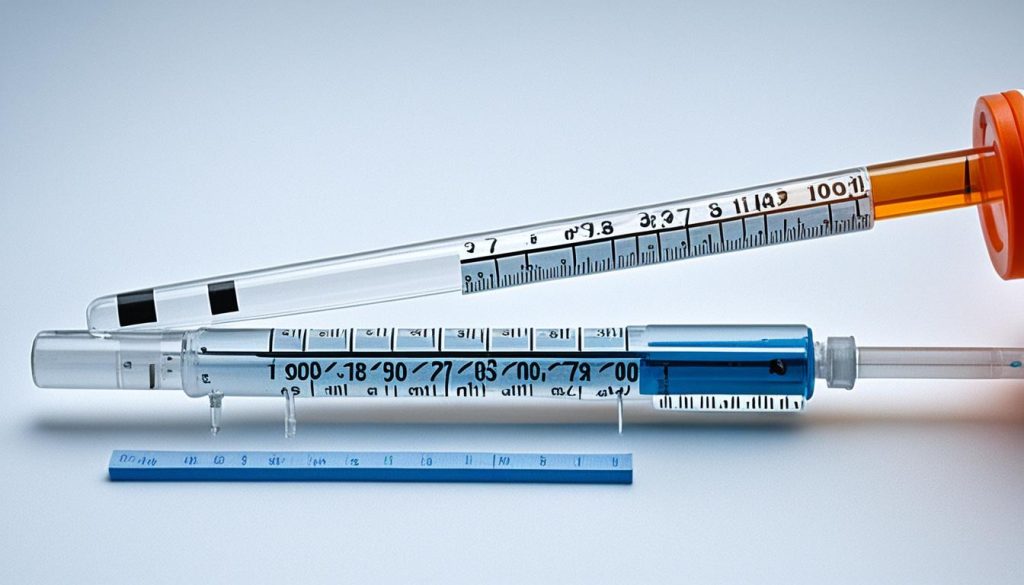
The image above visually demonstrates the relationship between milliliters and units in an insulin syringe, reinforcing the concept that 1 ml is equal to 100 units.
In the next section, we will dive deeper into insulin syringe unit conversion and further explore the relationship between milliliters and units. Stay tuned to enhance your understanding of dosage calculations and ensure accurate insulin administration.
Insulin Syringe Unit Conversion Explained
Understanding the conversion between milliliters (ml) and units in an insulin syringe is crucial for accurate dosage administration. In this section, we will delve deeper into insulin syringe unit conversion and provide a comprehensive understanding of how milliliters and units relate to each other. We will also guide you through the process of calculating dosage, from milligrams to milliliters and units, ensuring precise insulin administration.
The Relationship Between Milliliters and Units
The relationship between milliliters and units in an insulin syringe is fundamental to proper insulin dosage. While insulin doses are commonly measured in units, the syringes used to administer them are calibrated in milliliters. It is important to note that the concentration of insulin in the syringe can vary, and this will affect the conversion between milliliters and units.
Typically, 1 unit of insulin is equal to 0.01 ml. However, it is crucial to consult the prescribed insulin concentration, which might differ from this standard. Your healthcare provider will provide you with the specific conversion ratio based on the insulin concentration prescribed to you.
Calculating Dosage: From Milligrams to Milliliters and Units
Calculating the dosage from milligrams to milliliters and units requires understanding the concentration of the insulin being used. The prescribed concentration will determine the conversion ratio.
To convert from milligrams to milliliters, you need to know the concentration of the insulin and the prescribed dosage in milligrams. To calculate the milliliters, you can use the following formula:
Milliliters = Milligrams / Concentration
Once you have the dosage in milliliters, you can further convert it into units by multiplying the milliliters by the conversion ratio. For example, if the conversion ratio is 0.01 ml per unit, the formula would be:
Units = Milliliters / 0.01
It is essential to consult your healthcare provider or refer to an insulin conversion chart for accurate conversion ratios.
Using the provided insulin conversion chart can simplify dosage calculations and help ensure accurate insulin administration. It is crucial to always consult with your healthcare provider regarding the appropriate dosage and conversion ratio for your specific insulin prescription.
Types of Insulin Syringes and Their Capacities
In the market, there are various types of insulin syringes available to meet the unique needs of individuals with diabetes. These syringes differ not only in their design but also in their capacity. Understanding the different types of insulin syringes and their capacities is crucial for selecting the right one based on your prescribed dosage.
Let’s take a closer look at the three common sizes of insulin syringes:
- 0.3 mL (30 units) Insulin Syringe: This type of insulin syringe has a capacity of 0.3 mL, which allows for a maximum dosage of 30 units. It is suitable for individuals who require smaller insulin doses.
- 0.5 mL (50 units) Insulin Syringe: With a larger capacity of 0.5 mL, this insulin syringe can accommodate up to 50 units of insulin. It is commonly used by individuals who require moderate insulin doses.
- 1 mL (100 units) Insulin Syringe: The 1 mL insulin syringe has the highest capacity, allowing for a maximum dosage of 100 units. It is typically used by individuals who require higher insulin doses.
To give you a visual representation, here is a table summarizing the types of insulin syringes and their capacities:
| Insulin Syringe Size | Capacity (mL) | Maximum Insulin Dosage (units) |
|---|---|---|
| 0.3 mL (30 units) | 0.3 | 30 |
| 0.5 mL (50 units) | 0.5 | 50 |
| 1 mL (100 units) | 1 | 100 |
When selecting an insulin syringe, it is important to consult with your healthcare provider to determine the appropriate size based on your prescribed insulin dosage. Using the correct insulin syringe can help ensure accurate and safe administration of insulin.
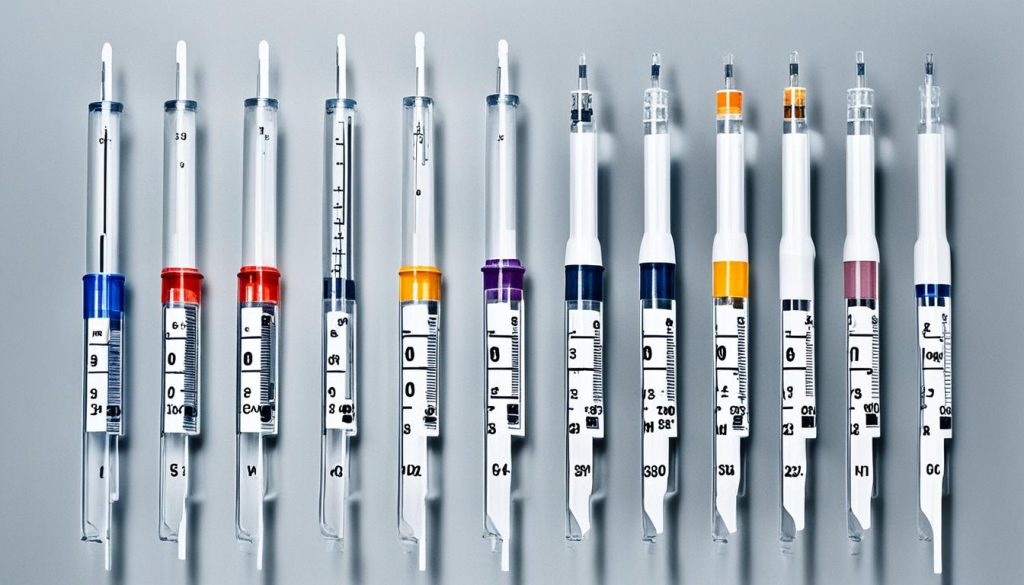
Choosing the Right Insulin Needle: Gauge and Length Considerations
When it comes to managing diabetes and administering insulin, choosing the right insulin needle is crucial. Two important factors to consider are the gauge and length of the needle. Let’s explore why these considerations are essential for a positive injection experience.
1. Insulin Needle Gauge
The gauge of an insulin needle refers to the size of the needle opening. Commonly available gauges range from 28 to 32, with a smaller number indicating a larger needle opening. When selecting an insulin needle gauge, it’s important to find a balance between needle comfort and insulin flow.
A higher gauge needle (e.g., 32 gauge) has a smaller needle opening, which can result in a virtually painless injection experience. These needles are more suitable for individuals who are sensitive to pain or have frequent injections. However, it’s important to note that higher gauge needles may cause insulin to flow more slowly.
On the other hand, a lower gauge needle (e.g., 28 gauge) has a larger needle opening, allowing for faster insulin flow. This may be preferable for individuals who require larger insulin doses or prefer a quicker injection process. However, it’s important to recognize that lower gauge needles may cause slightly more discomfort during injection.
2. Insulin Needle Length
The length of an insulin needle impacts the delivery of insulin into the subcutaneous tissue. Common needle lengths range from 4mm to 12.7mm. The appropriate needle length depends on several factors:
- Patient’s body composition: Individuals with thinner subcutaneous tissue may benefit from shorter needle lengths, such as 4mm or 5mm, to prevent accidentally hitting muscle tissue.
- Injection technique: The angle at which the needle is inserted can affect the required needle length. For subcutaneous injections, a 90-degree angle may require a longer needle length compared to a 45-degree angle.
- Patient preference: Some individuals may have a personal preference for longer or shorter needle lengths based on their comfort level during injections.
It is important to consult with a healthcare professional to determine the appropriate needle gauge and length based on individual needs and preferences.
By understanding the significance of needle gauge and length, individuals can make informed decisions when selecting an insulin needle that ensures painless injections and proper insulin delivery.
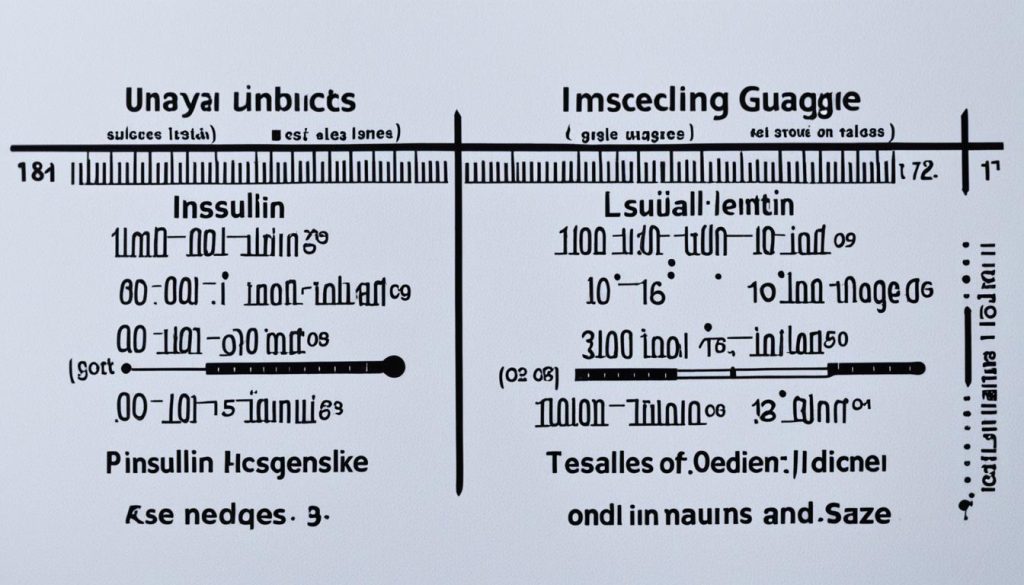
Practical Dosage Conversion: 1 ml is equal to how many units in insulin syringe
Understanding how to convert dosages from milliliters to units in an insulin syringe is crucial for accurate insulin administration. Let’s explore some practical examples to help you master the conversion process.
Example 1:
You have a prescription that requires a dosage of 50 units of insulin. You’re wondering, is 50 units equal to 1 ml?
To convert 50 units to milliliters, you need to know the insulin syringe’s conversion ratio. Different insulin syringes may have different ratios, so it’s essential to consult the markings on the syringe or refer to the manufacturer’s instructions. Generally, a commonly used conversion ratio is 1 ml to 100 units.
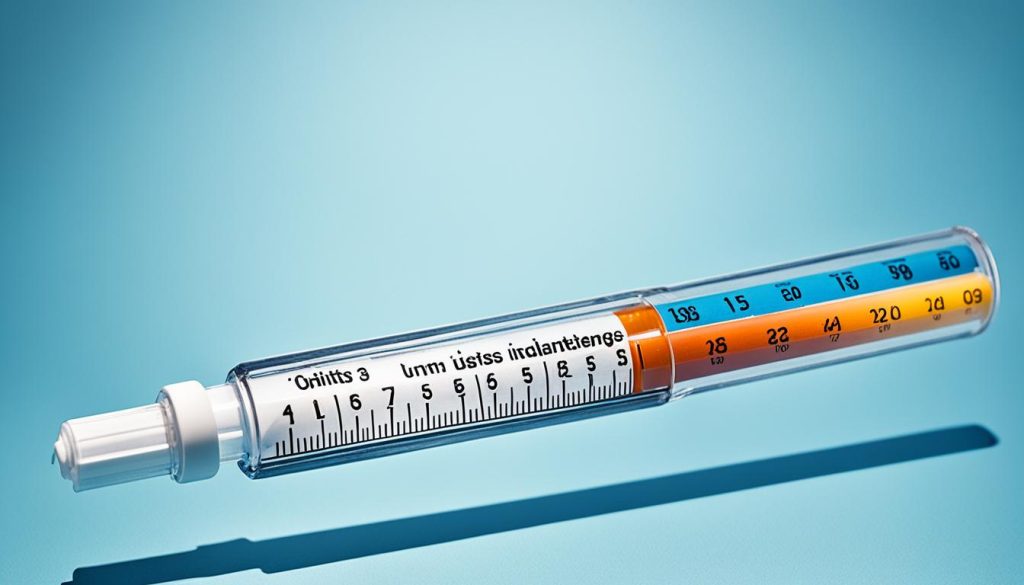
Using the conversion ratio of 1 ml to 100 units, we can calculate that 50 units would be equivalent to 0.5 ml. Therefore, 50 units is not equal to 1 ml in this example. It’s important to verify the specific conversion ratio on your insulin syringe for accurate dosage determination.
Example 2:
Your prescription specifies a dosage of 30 units. Now you’re wondering, how many milliliters are in 30 units?
Similar to the previous example, you need to know the conversion ratio on your insulin syringe. Let’s assume that the conversion ratio is 1 ml to 100 units.
Using this conversion ratio, we can calculate that 30 units would be equivalent to 0.3 ml. Hence, 30 units is not equal to 1 ml either.
By understanding practical dosage conversions and having accurate knowledge of the conversion ratio on your insulin syringe, you can confidently calculate dosages and administer insulin safely and effectively.
| Units | Milliliters (ml) |
|---|---|
| 10 | 0.1 |
| 20 | 0.2 |
| 30 | 0.3 |
| 40 | 0.4 |
| 50 | 0.5 |
Conclusion
Throughout this article, we have explored the important relationship between milliliters and units in insulin syringe measurements. By understanding this connection, you are now equipped to accurately calculate insulin dosages for effective administration.
Remember, 1 mL is equal to a certain number of units depending on the specific insulin syringe you are using. It is crucial to consult your healthcare provider or refer to the prescription for the correct conversion ratio.
In conclusion, when it comes to insulin administration, knowledge is key. By familiarizing yourself with the different types of insulin syringes and their capacities, as well as considering the appropriate needle gauge and length, you can ensure a comfortable and accurate insulin injection.
As a final tip, always follow the guidance of your healthcare professional regarding insulin dosage and administration. They can provide personalized advice based on your specific needs and medical history. With the understanding gained from this article and the support of your healthcare team, you can confidently and effectively manage your insulin dosage for optimal diabetes management.

